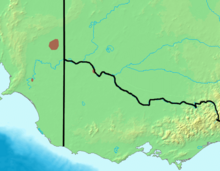Black-eared miner
| Black-eared miner | |
|---|---|
| Scientific classification | |
| Kingdom: | Animalia |
| Phylum: | Chordata |
| Class: | Aves |
| Order: | Passeriformes |
| Family: | Meliphagidae |
| Genus: | Manorina |
| Species: | M. melanotis |
| Binomial name | |
|
Manorina melanotis (Wilson, 1911) |
|
 |
|
| Distribution of the black-eared miner | |
The black-eared miner (Manorina melanotis) is an endangered honeyeater endemic to mallee woodland in south-eastern Australia.
It is closely related to the much more widely distributed yellow-throated miner M. flavigula and the taxonomic status of the black-eared miner is the subject of some controversy, with some researchers considering it a subspecies of M. flavigula.
Black-eared miners are co-operative breeders, living in colonies during the breeding season, and dispersing into the bush during non-breeding periods. Little is known of their movements during these periods.
Sites identified by BirdLife International as being important for black-eared miner conservation are areas containing relatively intact mallee woodland in north-western Victoria and south-eastern South Australia. They comprise Murray-Sunset, Hattah and Annuello, the Riverland Mallee, and Wyperfeld, Big Desert and Ngarkat.
Black-eared miners are listed as endangered on the Australian Environment Protection and Biodiversity Conservation Act 1999.
The species' conservation status in the following Australian states follows:
...
Wikipedia

